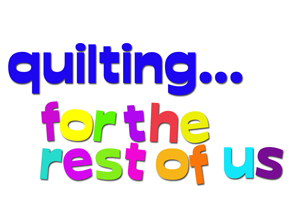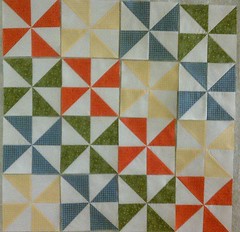This week's podcast episode, "In Which the Hexagons Attack," sorta officially launches a quasi-quilt-along that Jaye at www.artquiltmaker.com and Pam at www.hiptobeasquarepodcast.com and I are doing together using hexagons. Are we right in our heads, you may well ask? Remains to be seen. Especially after taking on projects using hexagons. I think I'll be all sorts of wrong by the time this is over.
So far I've worked out my design--kinda. (Have you noticed all the qualifiers I'm using in this post?) At least, I have an idea of where I'm heading and an idea of what it'll take me to get there. But I'm allowing myself elbow room for changes along the way. Organic, I think they call it. Allowing the quilt to speak for itself, they might say. Or, just hedging my bets. Which is more realistic but doesn't sound quite as artsy.
How is this a quasi-quilt-along? Well, we're not really giving you specific directions, patterns, designs, fabric quantities, or really anything else you can hang your hat on. Rather, we're giving you a process and a community. We're giving you links with information about the methods we'll be using, which you can find in the podcast show notes, or at Jaye or Pam's sites at the links above, and we'll be egging you on! We'll all be posting pics of our hexies in progress as we go, and sharing tips and tricks that we're picking up along the way. (Hint: There are no templates involved, and we're not hand-piecing. Although if that's your modus operandi, who am I to stop you?)
If you've never done a hexie before (like me), this is the perfect opportunity to try one out! Start with a small project (unlike me) and see how you like it.
If you've got hexie UFOs around, this is the perfect inspiration and encouragement to get 'er done! Did you get stuck on something? Post photos and get advice. Or just whine. We know how it feels.
If you're a hexie-afficianado and just want to do another one, come on board! Your experience is welcome.
Pam designed a great button for us to use--you'll see I've added it to the upper right of this blog. If you want to join us in making hexagons, go ahead and post the button on your blog too! Here's the link to it.
Leave a comment here or in the show notes to the podcast if you're on board! The more the merrier! Eventually I'll probably do some sort of give-away around it, just haven't gotten that far in my thinking yet. Let me at least get a few hexies cut, first....
So far I've worked out my design--kinda. (Have you noticed all the qualifiers I'm using in this post?) At least, I have an idea of where I'm heading and an idea of what it'll take me to get there. But I'm allowing myself elbow room for changes along the way. Organic, I think they call it. Allowing the quilt to speak for itself, they might say. Or, just hedging my bets. Which is more realistic but doesn't sound quite as artsy.
How is this a quasi-quilt-along? Well, we're not really giving you specific directions, patterns, designs, fabric quantities, or really anything else you can hang your hat on. Rather, we're giving you a process and a community. We're giving you links with information about the methods we'll be using, which you can find in the podcast show notes, or at Jaye or Pam's sites at the links above, and we'll be egging you on! We'll all be posting pics of our hexies in progress as we go, and sharing tips and tricks that we're picking up along the way. (Hint: There are no templates involved, and we're not hand-piecing. Although if that's your modus operandi, who am I to stop you?)
If you've never done a hexie before (like me), this is the perfect opportunity to try one out! Start with a small project (unlike me) and see how you like it.
If you've got hexie UFOs around, this is the perfect inspiration and encouragement to get 'er done! Did you get stuck on something? Post photos and get advice. Or just whine. We know how it feels.
If you're a hexie-afficianado and just want to do another one, come on board! Your experience is welcome.
Pam designed a great button for us to use--you'll see I've added it to the upper right of this blog. If you want to join us in making hexagons, go ahead and post the button on your blog too! Here's the link to it.
Leave a comment here or in the show notes to the podcast if you're on board! The more the merrier! Eventually I'll probably do some sort of give-away around it, just haven't gotten that far in my thinking yet. Let me at least get a few hexies cut, first....












